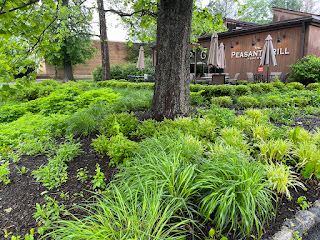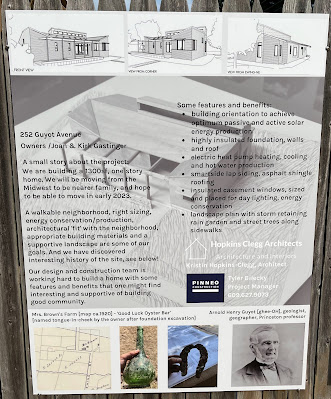A couple years ago, the town planted this raingarden next to the fuel tank on Witherspoon Street. They put in some pretty cultivars of showy native species like black-eyed susan, purple coneflower, and St. Johnswort, then mulched it all carefully. Everything looked under control, as gardens do when they are first planted.
Even this summer, with flowers blazing, it looks like a success.
But I can see that the seeds of its ultimate demise have already sprouted. This botanical drama has played out many times before--raingardens that failed for lack of strategic intervention when aggressive weeds started to move in.
Most deadly is the mugwort that has become established and is quickly spreading. That one invasive species alone could obliterate the intended plants in a few years.
Nutsedge, too, spreads rapidly.
Along with foxtail grass,
and barnyard grass, the nutsedge is obscuring a nice stand of soft rush the town planted two years ago.
More easily dealt with are the ragweed--a native weed with allergenic green flowers--
a flamboyant patch of crabgrass,
and what looks like a patch of black medic. The mulch laid down two years ago surely helped, but its capacity to stifle weed growth clearly didn't last.
And what's this vine, crawling out over the other plants? Ivyleaf morning glory is a new one for me.
Back in late April, when this photo showed the mugwort looking tamable, pullable, sprayable, I alerted the town that early detection and rapid response is what's needed to keep the weeds from taking over. The response was that a public works crew weeds the garden once or twice per year. That's not how a raingarden works. I know from long experience. Catch the aggressive weeds early, and the raingarden will ultimately become very easy to maintain.
Vikki Caines, a longtime member of the Recreation Department who recently retired, kept beautiful gardens growing in areas near the community pool. But that was a labor of love, done in her spare time. It's love, of a parental variety, that leads one to acquire plant knowledge in the first place, and then to grow a garden and anticipate its needs, and check for weeds, much more than once or twice per year.
How can your typical institution--where staff lack plant knowledge, motivation, and the flexibility in routine needed to catch problems early--successfully tend to a botanically complex raingarden planting? For the past 30 years, I've watched as many native raingardens and meadows planted by towns or universities have incrementally failed for lack of early and ongoing intervention by a knowledgeable caretaker. Maintenance requires more knowledge than installation, because the caretaker must know not only the intended plants but also the many species of weeds that inevitably try to move in. Yet we see over and over that money is invested in design and installation, while maintenance is deprived of funding and respect. We have doctors and nurses to care for people, but precious few plant doctors to care for landscapes.
A bit of good news: Last year, I wrote a google review of the Betsey Stockton Garden planted on top of the Princeton University's Firestone Library, pointing out that white clover and other weeds were invading the flower beds. Whether the review had an impact, I can't say, but the university is taking better care of the meadow planting this year.
Related Posts:
Followed two years later by:





















































